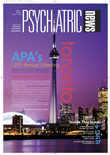At APA's 2006 annual meeting in Toronto, the National Institute on Alcohol Abuse and Alcoholism (NIAAA) is collaborating with APA on a series of sessions on recent advances in understanding and treating alcohol use disorders (AUDs) and highlighting issues related to the co-occurrence of AUDs with other drug use and mental disorders.
The collaborative sessions include more than 50 lectures, workshops, and symposia by nationally recognized experts. They explore the latest findings on at-risk drinking, alcoholism, and comorbidity and feature new resources and techniques in pharmacotherapy, screening, and other important clinical advances.
“This promises to be a terrific track at the annual meeting,” said Eric Strain, M.D., chair of APA's Council on Addiction Psychiatry.“ Along with NIAAA's release of its new publication, Helping Patients Who Drink Too Much—A Clinician's Guide, the track will give general psychiatrists substantial opportunities to update their clinical skills and learn about recent research findings related to alcohol use disorders.”
In keeping with the theme of this year's meeting, “From Science to Public Policy: Advocacy for the Profession and Patients,” several sessions address the mental health profession's broader influence on public policy in areas such as college drinking and the prevention of underage drinking. Other presentations explore the potential impact of data from recent studies—including NIAAA's National Epidemiologic Survey on Alcohol and Related Conditions (NESARC)—on developing the next edition of the Diagnostic and Statistical Manual of Mental Disorders (DSM-V).
Comorbidity a Key Issue
NESARC data indicated that almost 40 percent of people who reported a major depressive episode in their lifetime also had experienced AUDs. Significant rates of comorbidity were also found with co-existing anxiety disorders, antisocial syndromes, and other conditions, according to NIAAA Director Ting-Kai Li, M.D.
These data not only clarify the extent and severity of comorbidity, but also have immediate clinical implications. How can practitioners best screen for and diagnose alcohol problems among psychiatric patients? To what extent does alcohol misuse impact on psychiatric treatment? What types of interventions are effective among patients with comorbid alcohol and mental disorders? Does heavy alcohol consumption alter the effectiveness of psychiatric medications? Are there shared factors that contribute to the risk of AUDs and other psychiatric disorders? How might practitioners comprehensively address the need for specialized follow-up and referrals for people with addiction and co-occurring disorders? Several NIAAA-supported sessions are designed to offer information on advances in dual diagnosis, screening and brief intervention, and therapy.
Alcohol and Adolescent Development
According to Li, alcohol is the drug of choice among adolescents, and addressing alcohol disorders in young people remains a priority. Even as increasing scientific interest is shedding light on the effects of alcohol consumption on adolescent development, important opportunities exist for practitioners to address alcohol-related problems in young patients.
Li said, “This is the intersection where science and medicine can make significant progress, both by integrating screening and diagnosis for alcohol disorders in adolescents, as well as by influencing policy decisions about prevention, intervention, and treatment to safeguard the health of young people.”
A special symposium titled “Alcohol Use Disorders and Psychiatric Comorbidity” addresses important challenges in the psychiatric assessment and management of adolescents with AUDs and co-occurring mental illness. The objective of the session, which will be chaired by NIAAA Associate Director Howard B. Moss, M.D., is to inform clinical practitioners of research findings on the assessment and treatment of adolescent AUDs and specific comorbidities.
Bridging Research, Practice, and Policy
NIAAA and APA organizers have put together a wide range of sessions that feature leading specialists in pharmacotherapy, genetics, the neurobiology of alcoholism, and other fields.
Two sessions chaired by Mark L. Willenbring, M.D., director of NIAAA's Division of Treatment and Recovery Research, emphasize practical techniques for screening and brief intervention, motivational enhancement strategies, and the use of medications for AUDs and comorbid disorders in general psychiatric practice. The presentations highlight an important resource for psychiatrists and mental health professionals, NIAAA's 2005 edition of Helping Patients Who Drink Too Much—A Clinician's Guide.
A number of presentations focus on NESARC, the largest study ever conducted of the co-occurrence of psychiatric disorders among U.S. adults. The study's director, Bridget F. Grant, Ph.D., chief of NIAAA's Laboratory of Epidemiology and Biometry, will co-chair several sessions, including the symposium“ Substance Use Disorders: Planning a Research Agenda for DSM-V,” a look ahead at critical questions related to revisions in the criteria and definitions fundamental to psychiatry.
Finally, the symposium “Taking Science to Policy: Efforts to Reduce Harm Related to Alcohol Misuse” considers how mental health experts can leverage their unique expertise to promote policy changes. Case studies on underage drinking, drunken driving, and trauma-center policies are reviewed in this session, which will be co-chaired by Willenbring and Ralph W. Hingson, Sc.D., director of NIAAA's Division of Epidemiology and Prevention Research.
Each of the NIAAA sessions is noted in the annual meeting program as a“ Collaborative Session With the National Institute on Alcohol Abuse and Alcoholism.” ▪
